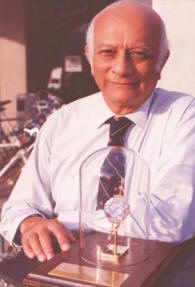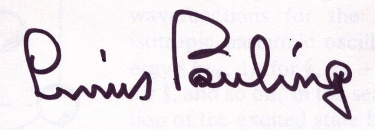Rustum Roy
September 3, 2010
Rustum Roy (July 3, 1924 - August 26, 2010), an early proponent of
materials science as a separate scientific discipline, and co-founder of the
Materials Research Society, died last week at age 86.[1-4] I met Professor Roy in the mid-1980s, when he paid a short visit to our industrial research facility. That was the only time that I saw him. Although I'm supposedly a materials scientist, I never traveled in materials science circles. I spent most of my time at topical conferences, such as the
Annual Conference on Magnetism and Magnetic Materials.

Photo from his personal web site.
Roy was associated his entire life with
Pennsylvania State University,
State College, PA, (a.k.a., Penn State) where he founded its Materials Research Laboratory (now the
Materials Research Institute), in 1962. Materials science is an interdisciplinary field that straddles the boundaries of
physics,
chemistry and
engineering, so Roy needed to bring together scientists from all these areas to found this laboratory, which he led from 1962-1985. Roy's final position at Penn State was Evan Pugh Professor Emeritus of the Solid State. Roy was elected a member of the
U.S. National Academy of Engineering (NAE) in 1973, the same year he co-founded the Materials Research Society. His NAE election citation reads, "Contributions to the development of the modern science and technology of non-metallic materials." Roy devoted some of his time to
Arizona State University, where he was Visiting Distinguished Professor of Materials. Because of his interest in the application of non-biochemical science to medicine, he was also a visiting professor of medicine at the
University of Arizona. He was also a member of the national science, or engineering, academies of
India,
Japan,
Sweden and
Russia.
Roy was born in India, and he came to Penn State in 1946 as a doctoral student in
ceramic science. He remained at Penn State as an assistant professor in 1951, becoming a professor of
geochemistry in 1957.[2,4] His most significant early work was the invention, in 1948, of the
sol-gel process, in which
hydroxides are fired to produce
oxide ceramic materials. Other work involved the synthesis and characterization of
barium titanate, an important
dielectric, and the synthesis of
diamond. These are just a few of his scientific accomplishments. His personal web site lists 797 career publications through 2007, so he's generally credited with "more than a thousand publications."
Some of his publications stray into unusual areas, including one book on sexual ethics[2] and another on radioactive waste management.[6] One widely cited paper involves the
structural conformation of
water molecules in solution as a possible explanation of
homeopathy.[7] Roy had an interest in
alternative medicine, and his involvement with the University of Arizona was in the area of integrative medicine and whole-person healing. I'm reminded of
Linus Pauling, who in his later years tried to show that
vitamin C is a cancer preventative. Most scientists were critical of Pauling's crusade, and likewise critical of Roy's adventures in alternative medicine. It's no wonder that
Newsweek called him the "leading contrarian" of US science.[4,6] He was Chair of the nonprofit organization, "Friends of Health," the goals of which are to "combine 'wisdom of the ages' together with the power of modern sciences to advance human healing;"[4] and research human healing based on materials science and physics instead of biochemistry.[6]

Linus Pauling's autograph.[8]
Roy was a Christian who was on the Planning and Strategy Committee of the
National Council of Churches from 1964-1970, and he was involved with several ecumenical organizations.[4,6] His funeral was on Sunday, August 29, 2010, at the University Baptist and Brethren Church, near Penn State, and a memorial service is planned at Penn State on Oct. 17.[1] Memorial contributions are directed to Friends of Health, 528 So. Pugh St., State College PA 16801.[1]
References:
- Gary Rotstein, "Obituary: Rustum Roy / World-class materials science expert at Penn State," Pittsburgh Post-Gazette, September 01, 2010.
- Influential materials scientist Rustum Roy dies, (Pennsylvania State University, August 27, 2010).
- Adam Smeltz, "Rustum Roy Dies At 86, Penn State Announces; Founded Materials Research Lab," Statecollege.com, August 26, 2010.
- Cliff White, "Renowned Penn State geochemist Roy dies at age 86," Centredailiy.com, August 27, 2010.
- Rustum Roy page on Wikipedia.
- Rustum Roy personal web site.
- Rustum Roy, W.A. Tiller, Iris Bell, M. R. Hoover, "The Structure of Liquid Water; Novel Insights from Materials Research; Potential Relevance to Homeopathy," Material Research Innovations, vol. 9, no. 4, pp. 577-608.
- Pauling autographed a reprint of this paper for me in 1982 - Linus Pauling, "The structure and oscillational motion of 57Fe atoms in interstitial sites in Al as determined from interference of Mössbauer γ radiation," Journal of Solid State Chemistry, vol. 40, no. 3 (December, 1981), pp. 266-269.
Permanent Link to this article
Linked Keywords: Rustum Roy; materials science; Materials Research Society; Annual Conference on Magnetism and Magnetic Materials; Pennsylvania State University; State College, PA; Materials Research Institute; physics; chemistry; engineering; U.S. National Academy of Engineering; Arizona State University; University of Arizona; India; Japan; Sweden; Russia; ceramic science; geochemistry; sol-gel process; hydroxides; oxide; ceramic materials; barium titanate; dielectric; diamond; structural conformation; water; homeopathy; alternative medicine; Linus Pauling; vitamin C; Newsweek; National Council of Churches.